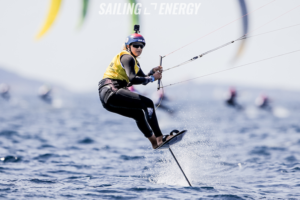 Happy to be racing on home turf this weekend in the West Marine / US Sailing Open Sailing Series on San Francisco Bay after some four months training in Europe, Daniela Moroz, World Champion kitefoiler, StFYC member and St Francis Sailing Foundation Grantee, offers some insight into her training, season highlights thus far, and decisions she’s made in order to move forward with her Olympic program.
Happy to be racing on home turf this weekend in the West Marine / US Sailing Open Sailing Series on San Francisco Bay after some four months training in Europe, Daniela Moroz, World Champion kitefoiler, StFYC member and St Francis Sailing Foundation Grantee, offers some insight into her training, season highlights thus far, and decisions she’s made in order to move forward with her Olympic program.
The Hyeres French Olympic Week regatta at the end of April was an incredible experience, highlighted by getting to work with a phenomenal sailor, person, and coach, Chris Draper. Most recently, he has been the wing trimmer on the Japanese SailGP Team, but also has an extensive professional and Olympic sailing resume having done more than a few successful America’s Cup and Olympic campaigns. However, it was his curiosity about kiting and eagerness to learn more about kites and foils that caught my attention when I was looking to work with some different experts to improve certain aspects of my game.
I arrived in Hyeres one week before racing to get some training time in at the venue and begin working with Chris in the lead up to the regatta. We had several days of training and practice racing in different conditions where Chris quickly learned the ropes of coaching kiting and we made some interesting conclusions regarding maneuver losses and different strategies depending on how powered you are on certain kite sizes.
I felt extremely prepared going into this regatta and was excited to start racing. It was another interesting first few days with many ups and downs in the qualifying series. My score line was not as consistent as I usually perform, but I was extremely proud of my progress with what I was working on with my starts and strategies, and Chris’ constant positive feedback was welcome encouragement as I often put too much pressure on myself when certain things didn’t go my way. It certainly wasn’t frustration, it was just a nagging in my mind telling me I could do better, and each race that’s exactly what I tried to do – everything a little bit better.
On the final day of the qualifying series, I managed to get 4 bullets out of 4 races, keeping me in first place and securing my spot in the final, meaning I only had to win one more race in a 4-boat final the following day to take the regatta win.
Finals day came around with a tricky onshore sea breeze. The wind was very marginal but pulsing, meaning there were phases of more wind followed by phases of less wind. Chris helped me identify the phase using the wind mast on the rib, and that information became extremely helpful in determining which side of the course would likely have more pressure by the time my start gun went off. Learning how to best utilize the wind information coming from the instruments on the coachboat was another essential takeaway experience, and it was a significant factor in my decision to start on port for the final race. My start put me in a controlling position off the start line, and then it was all about leading and covering the other 3 boards from there.
 Getting to work with Chris was such an honor and an incredible learning experience. He brought a new level of expertise and professionalism that I will carry further into my campaign, and we plan to continue working together here and there throughout the next 2 years.
Getting to work with Chris was such an honor and an incredible learning experience. He brought a new level of expertise and professionalism that I will carry further into my campaign, and we plan to continue working together here and there throughout the next 2 years.
I finished racing in Hyeres on Saturday, and I needed to be in Hawaii for my final exams at University by Tuesday. I got home to San Francisco on Sunday afternoon and immediately started working on all the schoolwork and final projects I had to catch up on before school on Tuesday. I’m still not entirely sure how I did it – and honestly, I’m not entirely sure how I managed to nearly complete my bachelor degree in 3 years while also doing my Olympic campaign and SailGP – but somehow, I managed to get it done. It was a stressful following few days as I had to complete all my exams, turn in all final projects, and then figure out what was next regarding school. I have a few more classes that I need to complete to get my degree, however they are all high-level in-person classes, and although I am committed to getting my degree, I realized that my current priority is my Olympic campaign, and my current goal is to go to the Games.
I don’t want to look back after the Olympic Trials or Games wishing that I had spent more time training or racing but couldn’t because of school. I decided to take a leave of absence from school for now to focus 100% of my time and energy into my Olympic campaign. I will return to the University of Hawaii in the fall of 2024 to finish up my last credits and officially get my degree. It was a difficult decision however I believe it is the best possible scenario for me right now.
I am extremely thankful for my family, friends, sponsors, coaches, and village for their continued support as I begin to chase my Olympic dreams full time. It’s a very exciting time and I look forward to sharing the journey with you all!
Images courtesy Daniela Moroz



 “Both days had light breeze as we towed out, medium breeze as we started, and medium-heavy breeze halfway throughout the day,” Hamlin reported. “The breeze would start right-favored, then clock left throughout the day. Both days there was swell and chop, while the first day was more choppy, and the second had more swell. Both days had no current.”
“Both days had light breeze as we towed out, medium breeze as we started, and medium-heavy breeze halfway throughout the day,” Hamlin reported. “The breeze would start right-favored, then clock left throughout the day. Both days there was swell and chop, while the first day was more choppy, and the second had more swell. Both days had no current.”


 Post racing on the final day of the event, we were still determined to find a solution. We took measurements of the hull fittings and their positions to gather data points to compare to our hull in the US. Our American teammates were also helpful in lending their equipment for measurement sake in order for us to get to the bottom of our speed deficit. Another day went by and again we were the last 49er to de-rig our boat in an attempt to understand why the hull felt stuck in the water. We came home knowing we fought every moment to find a solution.
Post racing on the final day of the event, we were still determined to find a solution. We took measurements of the hull fittings and their positions to gather data points to compare to our hull in the US. Our American teammates were also helpful in lending their equipment for measurement sake in order for us to get to the bottom of our speed deficit. Another day went by and again we were the last 49er to de-rig our boat in an attempt to understand why the hull felt stuck in the water. We came home knowing we fought every moment to find a solution.
 14-year-old Mila Kane from San Francisco has been sailing for seven years and has been on the TISC race team for 3-4 years. Sailing is her favorite sport, and she was excited to race keelboats for the first time.
14-year-old Mila Kane from San Francisco has been sailing for seven years and has been on the TISC race team for 3-4 years. Sailing is her favorite sport, and she was excited to race keelboats for the first time.




























































 “It was super tight, fun racing. Different people won almost every day and it was just consistency, it wasn’t how big you won by on the days you won, it was when you didn’t win the day just how close you were. We went into the final day just three points ahead of Holtie, it was one of the tighter NAs that I have sailed.”
“It was super tight, fun racing. Different people won almost every day and it was just consistency, it wasn’t how big you won by on the days you won, it was when you didn’t win the day just how close you were. We went into the final day just three points ahead of Holtie, it was one of the tighter NAs that I have sailed.”
 Martin hails from Alexandria, VA, where he grew up sailing out of Annapolis on the Chesapeake Bay and sailed in college at Old Dominican University. In addition to his 11 North American victories, he has won four World Championships in the 505, the first in 1999 with Howie Hamlin, in Luberon, France.
Martin hails from Alexandria, VA, where he grew up sailing out of Annapolis on the Chesapeake Bay and sailed in college at Old Dominican University. In addition to his 11 North American victories, he has won four World Championships in the 505, the first in 1999 with Howie Hamlin, in Luberon, France.


 I am so grateful to the St Francis Sailing Foundation for its support of my racing and my participation at the 2021 Moth World Championships. Thank you!
I am so grateful to the St Francis Sailing Foundation for its support of my racing and my participation at the 2021 Moth World Championships. Thank you!


 “Racing against so many Moths flying around at once will be nuts, and I am buzzing just thinking about it!” Scutt said. “I know that I’m going to learn so much at my first Moth Worlds this year that I already can’t wait to put what I’m going to learn into practice at the next Worlds!”
“Racing against so many Moths flying around at once will be nuts, and I am buzzing just thinking about it!” Scutt said. “I know that I’m going to learn so much at my first Moth Worlds this year that I already can’t wait to put what I’m going to learn into practice at the next Worlds!”